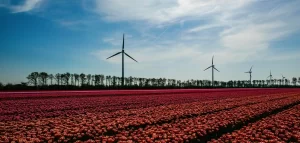The Department for Energy Security and Net Zero (DESNZ) has published the results of Allocation Round 6 (AR6) of its annual Contracts for Difference auction.[1] AR6 comes at a pivotal moment, with the Labour Government working to deliver its ambitious 2030 clean power mission. While AR6 has secured record-breaking additional renewable capacity across a range of technologies, the outcome highlights the significant challenges that lie ahead for the Government.
Brevia Energy offers a team of experienced energy consultants that provide straightforward public affairs and public relations support to companies and charities operating in the energy sector.
How much new capacity was contracted?
Overall, AR6 secured 9.6 GW of new renewable capacity, an increase of 161 per cent on AR5, which secured only 3.7 GW. Capacity was awarded across three pots, each covering different renewable technology groups.
Pot 1, which covers established technologies such as onshore wind, solar PV, and Energy from Waste secured 4.2 GW of capacity from a budget of £185m. Onshore wind and solar made up the entirety of these projects, securing 990 MW and 3.2 GW respectively.
Emerging technologies such as floating offshore wind, tidal, and geothermal competed in Pot 2, which secured 428 MW of capacity. Among the successful projects in this group was Green Volt Offshore Wind Farm, the largest commercial-scale floating offshore windfarm project in the world, with a generating capacity of 400 MW.[2]
The outcome of AR6 for offshore wind has been much anticipated due to the failure of AR5 to secure any offshore wind projects. Pot 3, dedicated to offshore wind, had the largest of all three budgets, set at £1.1bn.[3] Delivering 4.9 GW of capacity, AR6 is a significant step forward for the sector, however concerns remain over whether the Government’s action will still fall short of its ambitious targets for different technologies.
Is Labour on track to meet its decarbonisation targets?
Despite the progress made in AR6, there remains a gap between the capacity secured and Labour’s ambition for the sector. Alongside its 2030 mission, Labour has set clear targets for renewable capacity by 2030:
- 55 GW of offshore wind,
- 50 GW of solar,
- 35 GW of onshore wind,
- 5 GW of floating offshore wind.[4]
The Labour Party may only have three more Allocation Rounds remaining to reach these targets.[5] Moreover, the closer we get to 2030, the fewer technologies there will be with short enough delivery timescales to make a significant contribution. The success of the next couple of auctions is therefore of crucial importance to the Government’s mission.
Looking at offshore wind, the total contracted capacity in this round leaves a shortfall of approximately 21 GW when compared to Labour’s target of 55 GW by 2030.[6] Solar and onshore wind too face equally daunting challenges, with the current installed capacity for each technology sitting at 16.6 GW and 15.4 GW respectively.[7] This gap between reality and targets underscores the need for urgent and decisive action in AR7 to ensure that the Party can deliver on its manifesto commitments.
Implications for the Future
The outcome of AR6 offers several critical insights for the future of the UK’s renewable energy sector. First, it highlights the importance of sustained and increased ambition in future CfD rounds. Second, if the shortfalls identified in AR6 are not addressed, the Labour Government risks falling behind on one of its five key missions only a year into office, with potential consequences for both energy security and the Party’s electoral prospects. Third, industry and Government must collaborate closely to ensure that future auctions are aligned with the scale of investment needed to meet the challenges ahead. Industry must seize this moment to engage constructively with the Government, advocating for policies that support the rapid scaling of renewable technologies.
CfD AR6 represents a crucial step forward in the UK’s decarbonisation pathway, but it also reveals the scale of the challenge that remains to deliver clean power by 2030. The contracted capacity, while significant, falls short of the levels needed to meet Labour’s more ambitious targets. As the industry looks ahead to future CfD rounds, there is a clear need for greater ambition, collaboration, and urgency to ensure that the UK stays on course to meet its 2030 clean power mission.
BREVIA ENERGY PROVIDES STRAIGHTFORWARD PUBLIC AFFAIRS AND PUBLIC RELATIONS SUPPORT TO ORGANISATIONS OPERATING IN THE UK ENERGY SECTOR.
Discover how Brevia Energy can help you and your organisation by visiting: www.brevia.co.uk/sectors/energy/. You can also contact the Brevia Team on 020 7091 1650 or email contact@brevia.co.uk
[1] Department for Energy Security and Net Zero, ‘Contracts for Difference (CfD) Allocation Round 6: results’, 3 September 2024, Link
[2] Ed Miliband MP, Hansard, ‘Contracts for Difference (CfD) Allocation Round 6 Results’, 3 September 2024, WS, Link
[3] Department for Energy Security and Net Zero, ‘Contracts for Difference (CfD): Budget Revision Notice for the sixth Allocation Round’, 30 July 2024, Link
[4] The Labour Party, ‘Make Britain a Clean Energy Superpower’, 19 June 2023, Link
[5] Energy UK, ‘Mission Possible: The steps to make Britain a clean energy superpower’, 9 July 2024, Link
[6] Ibid.
[7] Department for Energy Security and Net Zero, ‘Energy Trends: UK renewables’, 30 July 2024, Link




